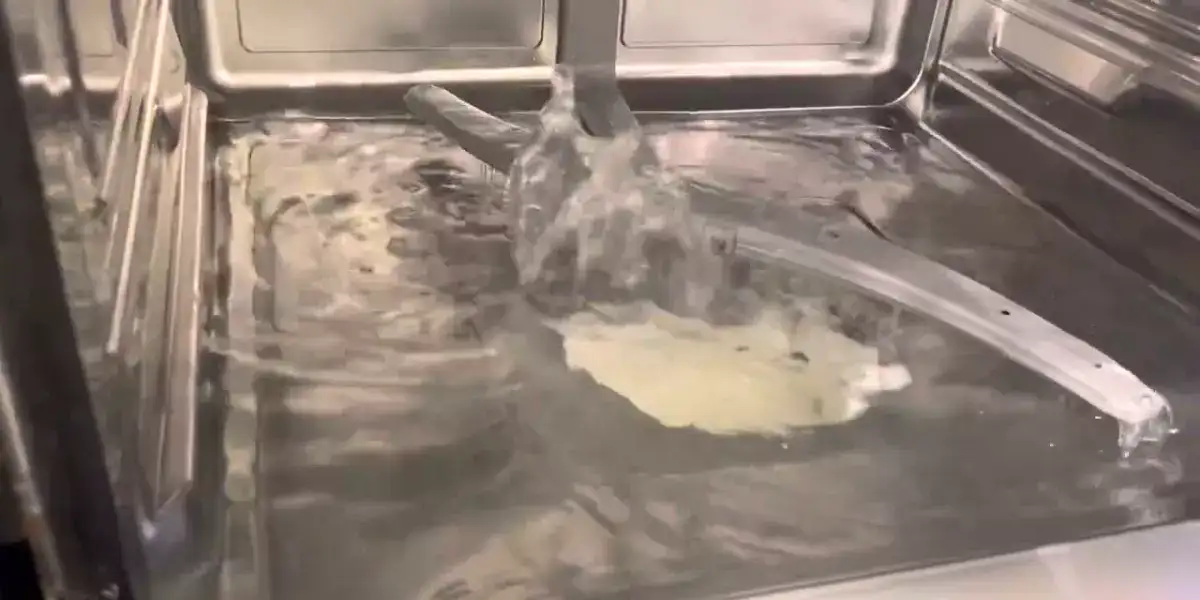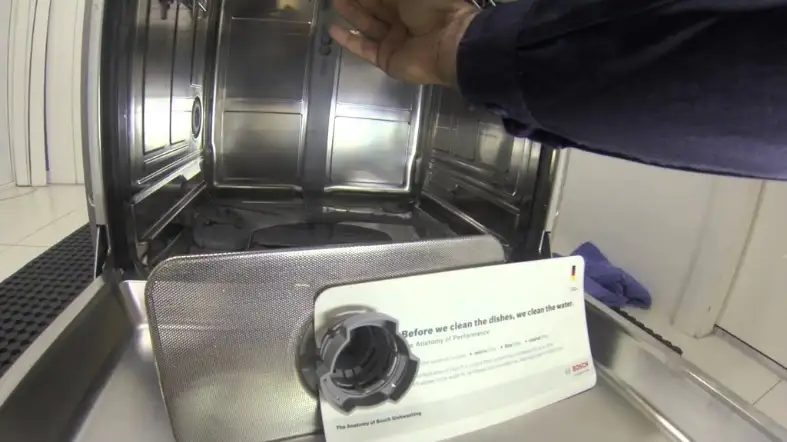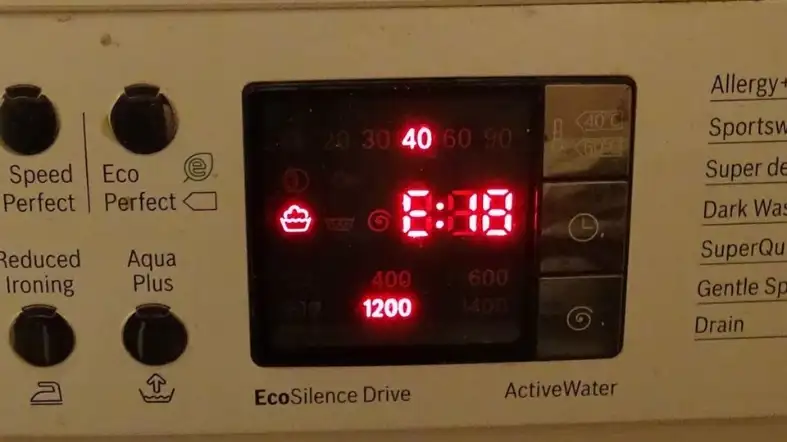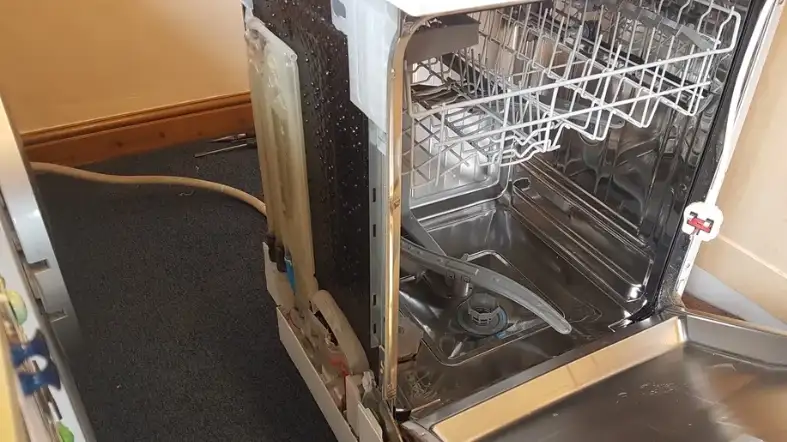Is your Bosch dishwasher failing to fill with water? A silent kitchen companion turns into a silent spectator.
In this article, we’ll explore the common causes of this issue and provide actionable solutions. Check out our tips for troubleshooting a Bosch dishwasher that isn’t filling up!

Common Reasons for Bosch Dishwashers Not Filling with Water
The most common reasons why Bosch dishwashers do not fill with water are as follows:
Turn off water valve or hose issue
A shutoff water supply valve can prevent Bosch dishwashers from filling with water. Before taking any other steps, ensure that the water supply valve is fully open.
Also, check the dishwasher hose for any kinks, clogs, or leaks that might be obstructing the water flow.
These simple issues are often the culprit behind a dishwasher not filling with water. Detecting hose issues or no water coming out of the valve is a sign that you should call a plumber.
Faulty Water Inlet Valve
A faulty water inlet valve can also prevent water from entering the dishwasher. During filling, water flows into the dishwasher through the water inlet valve.
If it is clogged with mineral deposits, it may block the water flow. Use a stiff brush and vinegar to clean the valve thoroughly, suggests Advance Appliance Service.
Vinegar helps dissolve mineral deposits effectively. If the valve is still not functioning correctly after cleaning, it might need to be replaced by a technician.
Professional intervention ensures that the replacement is done safely and efficiently.
Malfunctioning Door Switch
Door switches ensure that the dishwasher’s door is securely closed before the water enters. If the door switch malfunctions, it may not register the door as closed, even when it is shut.
If the dishwasher door is not closing completely, RD Appliance recommends listening for a distinct click as it shuts. You might need to replace the switch if you don’t hear a click or if it’s visibly damaged.
You should hire a qualified technician to assess the situation and repair or replace it as necessary.
Jammed or Broken Float Assembly
The float assembly is a device that monitors the water level inside the dishwasher. When the water reaches a certain level, the float assembly signals the dishwasher to stop filling.
If the float assembly becomes jammed or broken, it may not allow water to fill the dishwasher at all. Ready To DIY advises checking if the float assembly is stuck and gently freeing it if possible.
When it appears to be broken or damaged beyond repair, contact a technician. Installing floats correctly and ensuring they function as they should requires a skilled professional.
How to Troubleshoot Your Bosch Dishwasher?

These are some of the most common problems with Bosch dishwashers:
Check the Filter
A clogged or dirty filter is one of the most common causes of Bosch dishwasher problems.
The filter catches food particles and debris, improving cleaning efficiency and preventing odors. Bosch recommends cleaning the filter every two weeks or more often if dishes are very dirty.
Remove the filter from the dishwasher and rinse it under running water to clean it. Use a toothbrush to scrub away stubborn debris.
Check the Door Seal
A faulty or damaged door seal can affect the dishwasher’s performance. Dishwasher door seals prevent water from leaking and maintain adequate water pressure.
You may need a technician to replace the seal if you feel gaps or tears around the edges.
Check the Heating Element
The heating element plays a crucial role in heating water and aiding in dish cleaning and drying. Run a cycle without detergent and check if the water is hot at the end.
Having a technician replace the heating element if it’s cold or lukewarm can solve the problem.
Check the Spray Arms
The spray arms rotate and spray water on the dishes during the wash cycle. Blockages or lack of rotation can hinder effective cleaning.
Remove the spray arms and clean them with a stiff brush and vinegar to clear any debris. If damaged, consult a technician for replacement.
Check for Error Codes
Some Bosch dishwashers display error codes to indicate issues. Refer to the owner’s manual to troubleshoot the problem when you see an error code.
Error codes on Bosch dishwashers indicate a variety of problems. Some of the most common ones are:
| Error Code | Problem |
|---|---|
| E01, E02, E03, E04, E05 | Power module failure – control board issue |
| E12 | Limescale buildup in the dishwasher |
| E14 | Flow meter failure in the dishwasher |
| E15 | Water in the base trough of the dishwasher |
| E16, E17 | Problem with the water filling system of the dishwasher |
| E18 | Issue with the water flow into the dishwasher |
| E22 | Filter system blocked in the dishwasher |
How to Identify Low Water Supply Issues in Bosch Dishwashers (error codes E17 & E18)?

To identify low water supply issues, follow these steps:
Water Supply Hose and Valve
Check the Bosch dishwasher’s water supply valve and hose for low water supply issues.
Look for any kinks, clogs, or leaks in the hose. Make sure the valve is turned on and the hose is not damaged or twisted.
Test the Water Pressure
Next, close the water tap and remove the hose from the dishwasher’s water inlet. Place a bucket beneath the tap to catch the water.
Turn on the water tap and observe the flow. Water should flow out at a rate of about 10 liters per minute. Contact a plumber if the water pressure in your home is too low.
Check the Filter in the Inlet Hose
Inlet hose clogs can restrict water flow, causing low water supply problems. To check and clean the filter, turn off the water tap and remove the hose from the water inlet.
Clean the filter under running water using a small brush to remove any debris or buildup. Once cleaned, reconnect the hose to the water inlet and check for any leaks.
Check the Aqua Stop Device
Aqua stop devices are safety features that are located at the end of the dishwasher’s supply hose.
It prevents water from leaking out in case of a malfunction. A qualified technician may need to replace the aqua stop device if you suspect it is malfunctioning.
Check the Water Pressure Sensor
The water pressure sensor measures the water entering the dishwasher and regulates it. If the sensor is faulty, it may lead to a low water supply or other performance issues.
Consult a technician to diagnose the problem and determine whether the sensor needs to be replaced.
What causes a faulty water inlet valve?

There are a few things that can cause a faulty water inlet valve. These include:
Corrosion
Experiencing salt, chlorine, and other chemicals can cause corrosion of water inlet valves. These substances weaken the structure of the valve and can cause it to fail.
Regular maintenance and cleaning can help prevent corrosion and prolong the life of the valve.
Mineral Buildup
Another common cause of a faulty water inlet valve is mineral buildup. Calcium and magnesium levels are high in water when there is a high mineral content.
As these minerals accumulate inside the valve, they can form deposits that clog the valve’s openings. Regularly using a water softener or descaling agent can prevent mineral buildup.
Electrical Failure
Specifically, the solenoid coils are essential for the proper operation of the water inlet valve. A damaged solenoid coil or loose connection may prevent electric power from reaching the valve.
Test the continuity of the solenoid coils with a multimeter to ensure they are functioning properly.
Mechanical Failure
Mechanical failure can occur due to various reasons, including physical damage to the valve. Any cracks, leaks, or broken parts in the water inlet valve can affect its ability to control water flow.
Such damage can result from accidental impact, improper installation, or excessive wear and tear. Prevent mechanical failures by regularly inspecting the valve and addressing any signs of damage.
FAQs About Bosch Dishwasher Water Filling Problems
What Should I Do If I Suspect A Problem With The Water Inlet Valve?
It is best to address any issues with the water inlet valve as soon as you notice them.
Start by following the troubleshooting steps mentioned earlier.
For further assistance and professional repairs, contact Bosch customer service or a certified technician.
Are There Any DIY Cleaning Solutions For A Clogged Water Inlet Valve?
For minor clogs, you can try using a vinegar solution to dissolve mineral buildup in the valve.
Be cautious and avoid using harsh chemicals that may damage the valve or dishwasher components.
For significant clogs or persistent issues, it is best to seek professional help.
Can A Water Inlet Valve Problem Cause Other Dishwasher Malfunctions?
Yes, faulty inlet valves can disrupt dishwasher function, resulting in incomplete washing, poor cleaning, and error codes related to water supply.
Addressing the water inlet valve problem promptly can help prevent additional complications.
Water Inlet Valve Problem Myself?
Repairing or replacing the water inlet valve requires technical expertise, despite some simple troubleshooting steps.
For safe and accurate replacement, contact a qualified technician or service professional.
What Other Problems Can Cause A Dishwasher Not To Fill?
In addition to water inlet valve issues, several factors may play a role in dishwasher failures.
An accident or improper handling may cause damage to the valve due to low water pressure or electrical problems.
Identifying and resolving these issues may also require professional assistance.
Conclusion
If your Bosch dishwasher is not filling with water, don’t panic. Check the water supply valve and hose for any leaks, clogs, or damage that might be affecting water flow.
Mineral buildup or a faulty water inlet valve could also be the culprits. Regular maintenance and quick attention to any problems can ensure your dishwasher works flawlessly.
Remember, you can always seek professional help for reliable repairs and expert advice. Keep your dishwasher running smoothly and enjoy spotless dishes every time.

